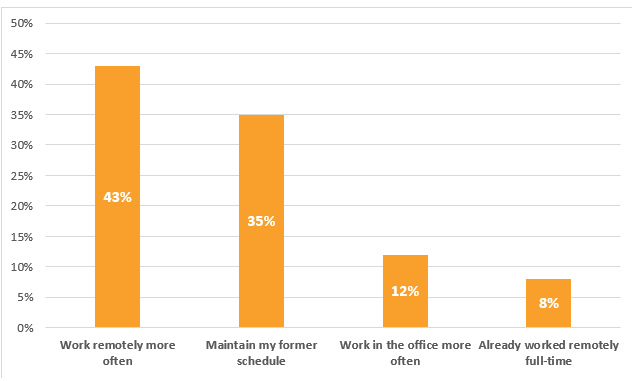Over the past 12 months, working from home (or WFH, as some now call it) has gone from being specific to certain professions to being very common. With COVID-19 restrictions coming and going and workplaces being temporarily closed, people have been forced to transform spaces in their homes into functional offices. This is something most haven’t found easy – being forced to work from bed or to clear a small area on the kitchen counter where they are constantly interrupted by their family. The situations many of us have found ourselves in are far from ideal but work from home looks like it’s here to stay for a large proportion of the nation’s workforce.
Globally, several big companies like Google, Twitter and Uber are claiming that staff are just as (if not more) productive whilst working remotely, so are giving them the option to work remotely indefinitely[i]. Smaller companies appear to be following the trend. Remote work has always been a faraway certainty, but the pandemic has brought it from the future into the present.
Despite the initial difficulties of setting up laptops and investing in a chair that won’t give you chronic back pain, working from home can be great for employers and employees. It means more free time, less money spent on commuting, and more work being completed. In a survey conducted by Statista, 43% of US respondents said they want to continue working remotely after COVID-19.

However, none of this is achievable without having the right office set-up and the right motivated mindset that lends itself to working from home. In this guide, we’ll tell you exactly how to work from home with success.
Where to set up your home office
Few places in the house make an ideal home office environment, but you can make anywhere work with some creativity. During lockdown, we’ve heard about people utilising the following spaces in their homes:
- Spare room – your spare room can easily double up as an office. If you’re working with minimal space, think about replacing the bed with a sofa bed or futon so it can fold away whilst not in use.
- Garage – with a little bit of prep work, your garage can make the perfect home office space if you only use it for storage. Make sure yours is completely watertight before setting up any expensive electrical kit.
- Shed – many people re-purpose summer houses or sheds as offices. With the right set up and a reliable underfloor heating system for cold winters, your shed could create a very comfortable office environment.
- Kitchen or dining room – in a pinch, you may have to work from your kitchen or dining room table. This isn’t the end of the world, but It might be worth investing in some noise cancelling headphones!
Your workspace
Setting up a functional workspace is the most critical aspect of working from home that you need to consider. It’s preferable to have a dedicated room, especially if you don’t live alone or have children, but you can easily create a space to work from if you don’t have a room spare. So, what do you need to think about when designing your workspace?
Ergonomics
Ergonomics are key to choosing the right office furniture. To ensure your back stays in good nick, consider the following[ii]:
- Monitor – your PC or laptop monitor should be below the horizontal optical axis of your eye, and a minimum of an arm’s length away from where you are sat.
- Sit upright – sit upright with your elbows and knees at right angles. This will stop pain developing.
- Feet – your feet should be firmly planted on the floor whilst you work. If they dangle, invest in an adjustable foot stool.
- Keyboard and mouse – these should be in line with your elbows. Use hand rests to prevent your hands from bending.
The correct height for your desk and chair will depend on your height. You can calculate it here.
Desk + chair
As a bare minimum for your home office furnishings, you need a spacious table or desk and a chair. If you are working from home on a permanent or semi-permanent basis, investing in an ergonomic chair is well worth it. Sitting in a spare dining chair or stool is ok every so often, but over time your back will really start to suffer. If you don’t have space for a desk, your dining table will do the job. Just make sure you meet as many ergonomic requirements as possible.
Computer set up
Whether you have a full PC or a laptop, you should make sure you have an optimal tech set up to allow you to work efficiently. Unless you work for yourself, your company should supply everything you need on this front to allow you to work comfortably. If you think you need something to make remote work easier, you should request it. Some nice office extras are:
- A laptop or monitor stand to bring your screen up to the right height
- A second monitor
- A laptop docking station
- A printer/scanner/photocopier
- An external keyboard and mouse (if using a laptop)
Light
Good, adjustable lighting is essential for any working environment. As well as having effective permanent lighting fixtures, you need to consider your lighting for video conferences. Having a bright daylight lamp that you can move around will help with this.
Try to make sure you aren’t sitting facing or with your back to a window to limit eyestrain. Avoid using fluorescent bulbs instead of using daylight or full-spectrum options that are not as harsh on your eyes.
How to stay motivated working from home
Now your office is set up, we’ll look at how you can stay motivated whilst working from home. Although many people find themselves working from home better than they would within an office, others really struggle to get their head down and produce high quality work. The trick is keeping yourself motivated, and here’s how you can do just that:
- Get up and get dressed in the morning. It’s so easy to slip into a routine of rolling out of bed and jumping straight into work. Getting dressed and going through a proper routine in the morning will help you start with a fresh head and help you to mentally separate work time and free time.
- Take breaks. People struggle with working from home because co-workers don’t know when they are or aren’t at their desks, and they are constantly reachable through their phone and through messaging apps. It’s very easy to work much longer hours than you mean to. Tell your team when you are taking your break, and let your brain turn off for a while.
- Go outdoors. If you’re able to, go for a short walk on your lunch break or just sit outside. The fresh air will invigorate you and you’ll be able to return to your desk feeling refreshed.
- Eat and sleep well. Looking after yourself is the most effective way to inspire a better work from home mindset. Giving your brain the fuel it needs to function well day in, day out, will set you up for success.
Remember you can do this!
Whether or not you are comfortable with the idea of remote working, there will be times where it’ll become stressful and overwhelming. Just remember that anything is possible with the right motivation and mindset, and you should never be afraid to ask your workplace for additional help or support should you need it.
References
blitzresults.com, n.d. Ergonomic Office: Calculate optimal height of Desk, Chair / Standing Desk. [Online] Available at: https://www.blitzresults.com/en/ergonomic/ [Accessed March 2021].
Hadden, J., 2021. 17 Major Companies That Have Announced Employees Can Work Remotely Long Term. [Online] Available at: https://www.entrepreneur.com/article/354872 [Accessed March 2021].
Sources
[i] https://www.entrepreneur.com/article/354872
[ii] https://www.blitzresults.com/en/ergonomic/
